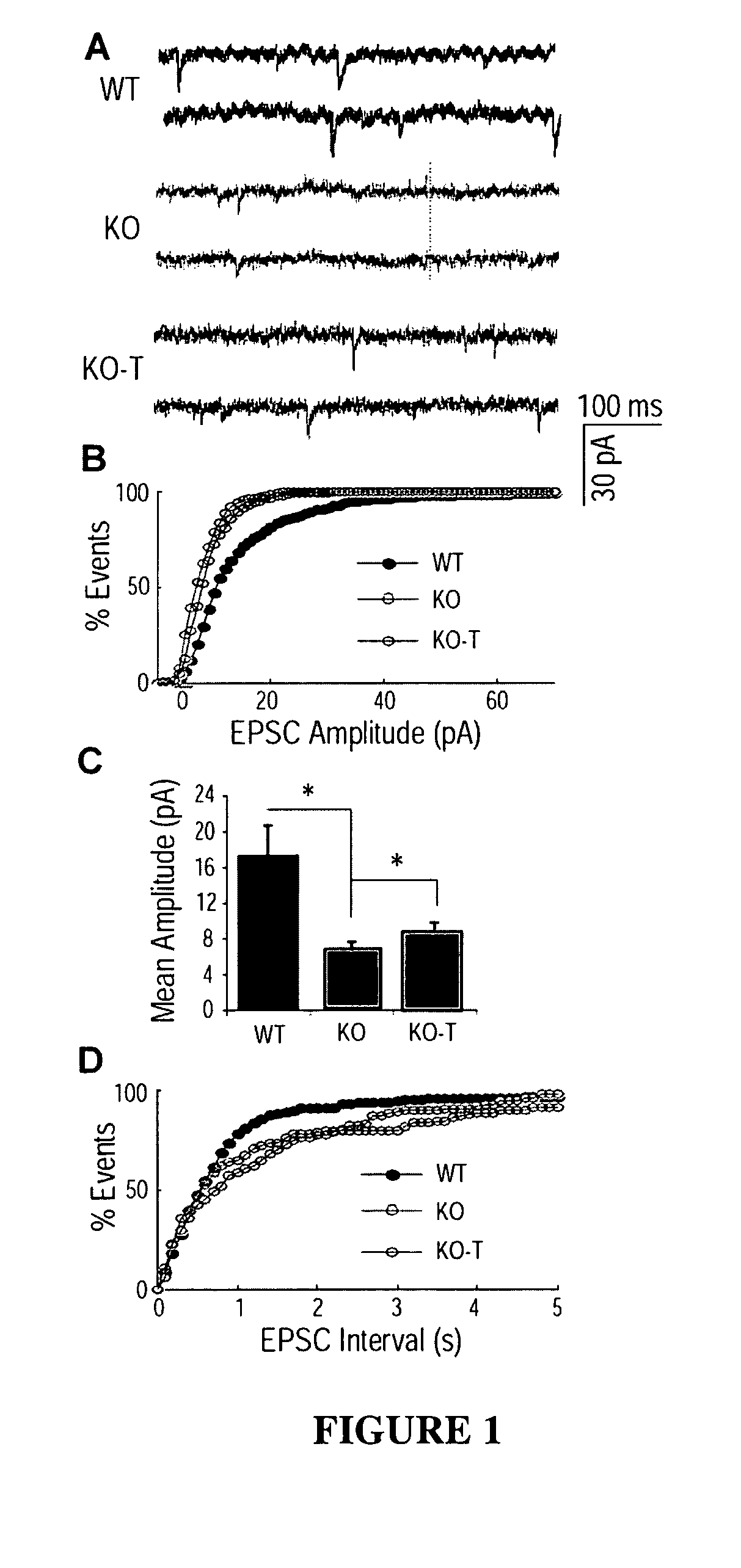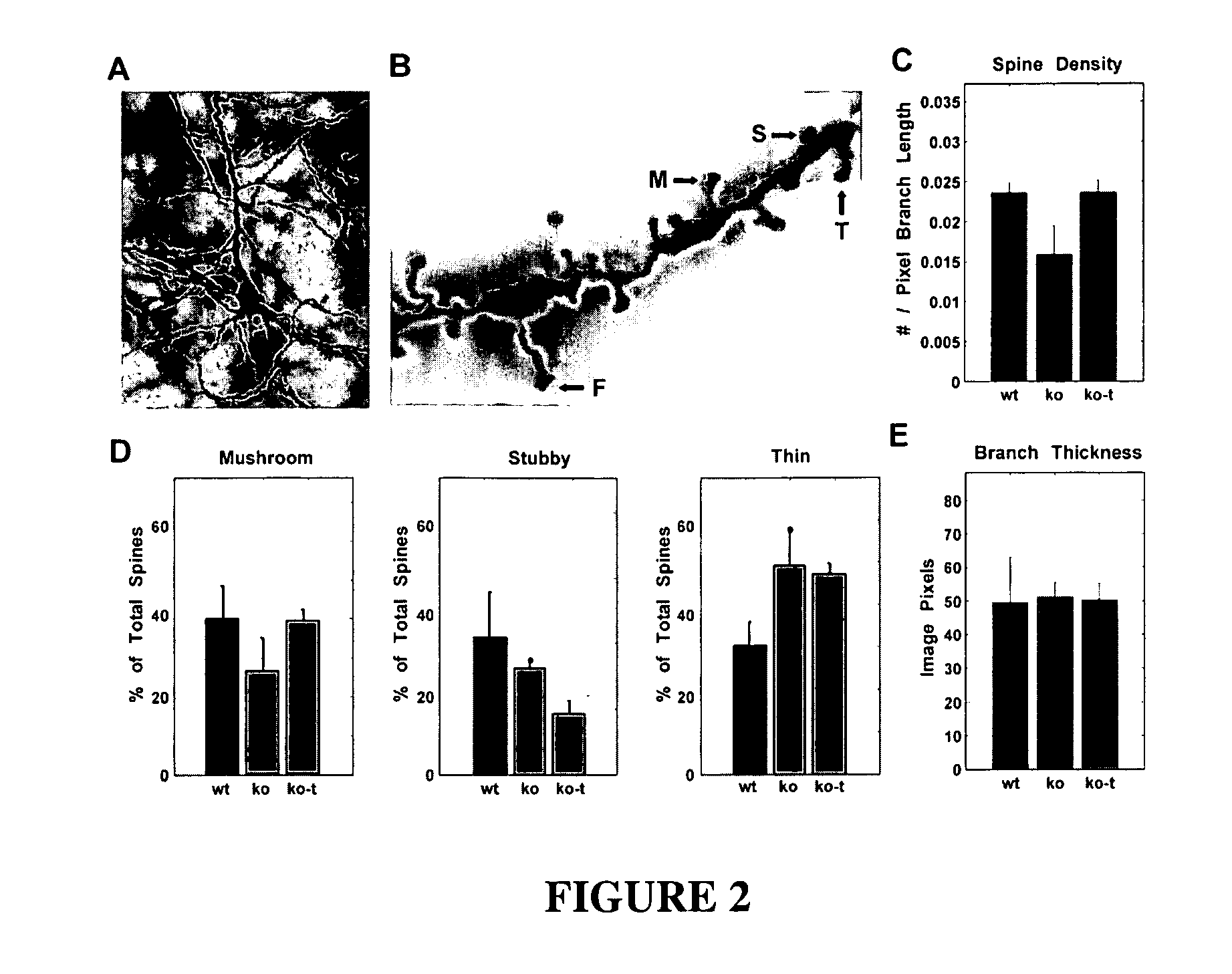Treatment of rett syndrome and other disorders
a technology for applied in the field of treatment of rett syndrome and other disorders, can solve problems such as inhumane practicality
- Summary
- Abstract
- Description
- Claims
- Application Information
AI Technical Summary
Benefits of technology
Problems solved by technology
Method used
Image
Examples
example 1
[0166]Rett Syndrome (RTT) is an X-linked neurological disorder that affects 1 in 10,000-15,000 live births (Chahrour and Zoghbi, 2007). The disorder is characterized by seemingly normal postnatal development followed by a sudden growth deceleration associated with progressive loss of acquired motor and language skills, stereotypic hand movements, muscle hypotonia, autonomic dysfunctions and severe cognitive impairment. There remains no specific treatment for RTT and management is mainly symptomatic and individualized.
[0167]In ˜85% of patients suffering from RTT, the cause is a mutation in the gene coding for methyl CpG-binding protein 2 (MECP2) (Amir et al., 1999), a global transcriptional repressor (Nan et al., 1998) that is strongly expressed in the central nervous system (CNS) following the onset of neuronal maturation and synaptogenesis (Cohen et al., 2003; Shahbazian et al., 2002b). Mouse models have been generated in which CNS-specific deletion of Mecp2 is sufficient to cause ...
example 2
(1-3)IGF-1 Increases the Expression And Biological Activity of BDNF And tPA
[0195]The effect of (1-3)IGF-1 treatment on the expression and biological activity of BDNF and tPA during MD was examined. Mice were subjected to MD and treated with (1-3)IGF-1 as described above.
[0196]FIG. 8A shows the effects of (1-3)IGF-1 treatment on the expression levels of BDNF at the mRNA level. Monocular deprivation significantly decreased BDNF expression level in the contralateral V1. (1-3)IGF-1 treatment was able to increase expression in animals subjected to MD, though not to control levels.
[0197]FIG. 8B shows double staining for NeuN (green) and proBDNF (red) antibody. The protein expression confirms that (1-3)IGF-1 treatment was able to modulate the effects of MD by increasing BDNF protein expression, though not to control levels.
[0198]FIG. 8C shows the effects of (1-3)IGF-1 treatment on the mRNA expression levels of tPA at the mRNA level. (1-3)IGF-1 treatment significantly up-regulated tPA mRNA ...
example 3
IGF1 Exhibits Same Effects As (1-3)IGF-1
[0201]The above data focused on the (1-3)IGF-1 fragment of IGF1 to promote IGF1 signaling. We also have tested the effect of the full-length IGF1 peptide already approved for pediatric administration in human patients (for short stature indications). We have verified a correspondence in the effects of (1-3)IGF-1 and recombinant human IGF1 (rhIGF1). We measured effects on synaptic transmission during direct application of the two molecules, and found that they each succeeded comparably in eliciting striking enhancements of synaptic activity (FIG. 9A). Also, maturation of cortical circuitry during ocular dominance plasticity (i.e., as shown in Example 1) was promoted to similar degrees using either (1-3)IGF-1 or rhIGF1 (180 μg / kg / day delivered i.p. starting at 2 weeks, shown in FIG. 9B).
PUM
| Property | Measurement | Unit |
|---|---|---|
| pH | aaaaa | aaaaa |
| temperature | aaaaa | aaaaa |
| temperature | aaaaa | aaaaa |
Abstract
Description
Claims
Application Information
 Login to View More
Login to View More - R&D
- Intellectual Property
- Life Sciences
- Materials
- Tech Scout
- Unparalleled Data Quality
- Higher Quality Content
- 60% Fewer Hallucinations
Browse by: Latest US Patents, China's latest patents, Technical Efficacy Thesaurus, Application Domain, Technology Topic, Popular Technical Reports.
© 2025 PatSnap. All rights reserved.Legal|Privacy policy|Modern Slavery Act Transparency Statement|Sitemap|About US| Contact US: help@patsnap.com



